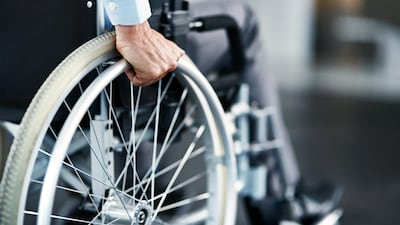Growing up in Iraq and the UK as a disabled woman in a wheelchair, I longed for a mentor or a disabled role model to motivate me to pursue my passion, or even just to accept me for myself.
I constantly tried to blank out my disability. I did not reject it entirely as I knew from a young age that I was different to others, but acknowledging it meant accepting defeat. I thought it would mean following a path with no future, as I had never encountered a disabled person in a professional capacity.
As a pupil at a special-needs primary school in the UK, our class was visited by Graeae, a professional theatre company for disabled performers co-founded by Nabil Shaban, a British Arab. It was then that I began to believe my secret desire to be an actress could be achieved after all, and that my disability would not be an obstacle. I studied drama and imagined myself performing on stage but, as I got older, I dropped the idea when I failed to see any disabled people on television and did not feel I would get the support I needed.
As the years passed, attitudes to disability were slowly being challenged and disabled people began to be recognised as equal members of society in different fields across the workforce. Yet, although in recent years the Arab region has improved in facilities for disabled people with a number of organisations, few are led by people actually living with disability.
We need more vocal, visible disabled people leading charities and NGOs that specialise in disability. Sadly, the majority of disabled organisations are not user-led, which means disabled people are on the receiving end of change, rather than instigating it themselves. This reinforces the idea that they need help to achieve anything, rather than feeling empowered to lead, and consequently diminishes the hopes and aspirations of many young disabled people, as they have no role models to show them what can be done.
Regionally, I found that fewer than 10 organisations were actually led by disabled people. In Egypt, for example, one non-profit organisation says that it aims to promote the full inclusion of disabled people in society and particularly in the workforce. All well and good, but it was founded and is now led by able-bodied people; its ambassadors are disabled, but none appear to be leading projects.
In the UAE, there are numerous charities and organisations challenging the status quo of disabled people and working on wider inclusion but the vast majority are not led by the people they serve. This is problematic: how can you represent a community of people when you have never experienced their situation? Even the language used by some of these organisations is of the kind you would never find a disabled person using to describe themselves.
In the UK, I found most disability activists were people with disabilities themselves. Charities and advocacy organisations are often led by disabled users. This is important as it doesn’t perpetuate an environment where people with disabilities wait to be gifted their rights by non-disabled people. When that happens, you are dependent on what others think you need, not what you actually know you need.
Instead of putting pressure on people with disabilities to be more determined and to fight harder for their rights, we should be putting pressure on society to provide accessible tools and spaces, so that people with disabilities can join in with everyone else.
There is a contradictory view that people seem to have of those with disabilities. Some see us as superheroes because our daily life is so unimaginable that only a person with superpowers could make it through, let alone excel professionally or personally – a view that negates the need to provide accessibility. At the other end of the spectrum, we are confronted with pity, because we are seen as helpless and desperately in need of sympathy and prayers.
Both views are counter-productive. Why can’t they fathom that a person with a disability is just an ordinary human being?
Attitudes will only change when society sees active disabled people leading organisations and engaging with others, sparking tolerance and acceptance. If children were taught from a young age that disability is not a miserable state of being, if they were encouraged to mix and learn that disability is not something to be feared, then we would have greater acceptance.
Projects like The Four Biscuits, run by four young women with Down syndrome in Egypt; Accessible Jordan, founded by a wheelchair user named Aya Aghabi; ihelp, run by Rasha Ernest; Handi Label, led by wheelchair user Abdelfattah Haddani; and Iraq’s Short Stature Association, run by Mohammed Idan Jabbar, a person of short stature himself, all provide positive signs in the world of disability.
The more disabled people there are at the forefront of organisations, the more likely society will begin to see that we are equal members of our communities and can contribute greatly – culturally, professionally and economically.
Raya Al Jadir is a freelance journalist and co-founder of the first Arabic lifestyle e-magazine of its kind, Disability Horizons Arabic

